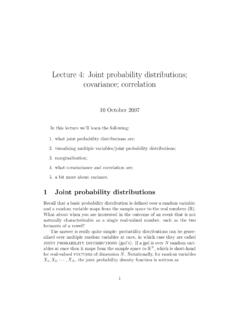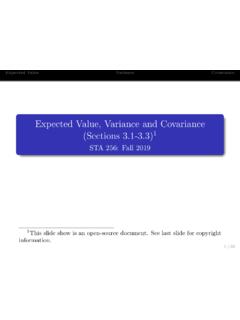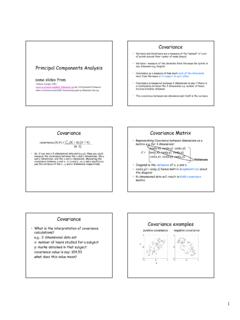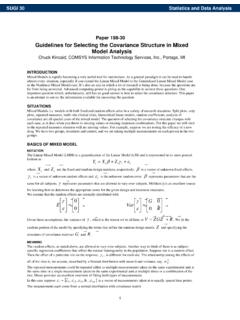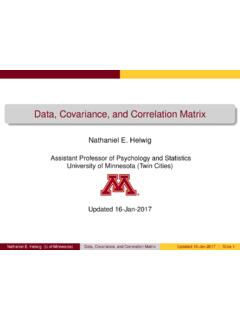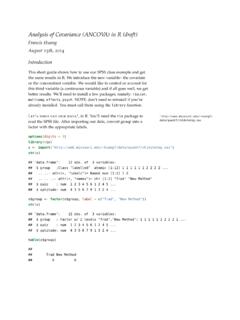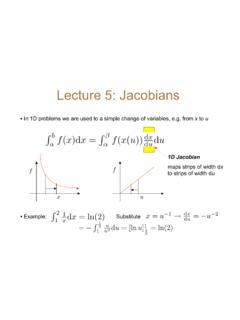Transcription of VICR -INVARIANCE-COVARIANCE RE GULARIZATION FOR …
1 Published as a conference paper at ICLR 2022 VICREG: VARIANCE-INVARIANCE-COVARIANCERE-GULARIZ ATION FORSELF-SUPERVISEDLEARNINGA drien Bardes1,2 Jean Ponce2,4 Yann LeCun1,3,41 Facebook AI Research2 Inria, cole normale sup rieure, CNRS, PSL Research University3 Courant Institute, New York University4 Center for Data Science, New York UniversityABSTRACTR ecent self-supervised methods for image representation learning maximize theagreement between embedding vectors produced by encoders fed with differentviews of the same image. The main challenge is to prevent acollapsein whichthe encoders produce constant or non-informative vectors. We introduce VICReg(Variance -INVARIANCE-COVARIANCE Regularization), a method that explicitly avoidsthe collapse problem with two regularizations terms applied to both embeddingsseparately: (1) a term that maintains the variance of each embedding dimensionabove a threshold, (2) a term that decorrelates each pair of variables.
2 Unlikemost other approaches to the same problem, VICReg doesnotrequire techniquessuch as: weight sharing between the branches, batch normalization, feature-wisenormalization, output quantization, stop gradient, memory banks, etc., and achievesresults on par with the state of the art on several downstream tasks. In addition, weshow that our variance regularization term stabilizes the training of other methodsand leads to performance representation learning has made significant progress over the last years, almostreaching the performance of supervised baselines on many downstream tasks Bachman et al. (2019);Misra & Maaten (2020); He et al. (2020); Tian et al. (2020); Caron et al. (2020); Grill et al. (2020);Chen & He (2020); Gidaris et al.
3 (2021); Zbontar et al. (2021). Several recent approaches rely onajoint embedding architecturein which two networks are trained to produce similar embeddingsfor different views of the same image. A popular instance is the Siamese network architectureBromley et al. (1994), where the two networks share the same weights. The main challenge withjoint embedding architectures is to prevent acollapsein which the two branches ignore the inputs andproduce identical and constant output vectors. There are two main approaches to preventing collapse:contrastive methods and information maximization methods. Contrastive Bromley et al. (1994);Chopra et al. (2005); He et al. (2020); Hjelm et al. (2019); Chen et al. (2020a) methods tend to becostly, require large batch sizes or memory banks, and use a loss that explicitly pushes the embeddingsof dissimilar images away from each other.
4 They often require a mining procedure to search foroffending dissimilar samples from a memory bank He et al. (2020) or from the current batch Chenet al. (2020a). Quantization-based approaches Caron et al. (2020; 2018) force the embeddings ofdifferent samples to belong to different clusters on the unit sphere. Collapse is prevented by ensuringthat the assignment of samples to clusters is as uniform as possible. A similarity term encouragesthe cluster assignment score vectors from the two branches to be similar. More recently, a fewmethods have appeared that do not rely on contrastive samples or vector quantization, yet producehigh-quality representations, for example BYOL Grill et al. (2020) and SimSiam Chen & He (2020).They exploit several tricks: batch-wise or feature-wise normalization, a "momentum encoder" inwhich the parameter vector of one branch is a low-pass-filtered version of the parameter vector of theother branch Grill et al.
5 (2020); Richemond et al. (2020), or a stop-gradient operation in one of thebranches Chen & He (2020). The dynamics of learning in these methods, and how they avoid collapse,is not fully understood, although theoretical and empirical studies point to the crucial importanceof batch-wise or feature-wise normalization Richemond et al. (2020); Tian et al. (2021). Finally, an1 [ ] 28 Jan 2022 Published as a conference paper at ICLR 2022 ( ) ( ) ( ) ( , )It ~ Tt!~ TXZY ( ) ( )X Z Y (+ )+ Tt,t !, !" #, #"IX, X Y, Y Z, Z : maintain variance: bring covariance to zero: minimize distance: distribution oftransformations: random transformations: encoders: expanders: batch of images: batches of views: batches of representations: batches of embeddingsFigure 1:VICReg: joint embedding architecture with variance, invariance and a batch of imagesI, two batches of different viewsXandX are producedand are then encoded into representationsYandY.
6 The representations are fed to an expanderproducing the embeddingsZandZ . The distance between two embeddings from the same image isminimized, the variance of each embedding variable over a batch is maintained above a threshold, andthe covariance between pairs of embedding variables over a batch are attracted to zero, decorrelatingthe variables from each other. Although the two branches do not require identical architectures norshare weights, in most of our experiments, they are Siamese with shared weights: the encoders areResNet-50 backbones with output dimension 2048. The expanders have 3 fully-connected layers ofsize class of collapse prevention methods relies on maximizing the information content ofthe embedding Zbontar et al.
7 (2021); Ermolov et al. (2021). These methods preventinformationalcollapseby decorrelating every pair of variables of the embedding vectors. This indirectly maximizesthe information content of the embedding vectors. The Barlow Twins method drives the normalizedcross-correlation matrix of the two embeddings towards the identity Zbontar et al. (2021), while theWhitening-MSE method whitens and spreads out the embedding vectors on the unit sphere Ermolovet al. (2021).2 VICREG:INTUITIONWe introduce VICReg (Variance -INVARIANCE-COVARIANCE Regularization), a self-supervised method fortraining joint embedding architectures based on the principle of preserving the information content ofthe embeddings. The basic idea is to use a loss function with three terms: Invariance: the mean square distance between the embedding vectors.
8 Variance: a hinge loss to maintain the standard deviation (over a batch) of each variable ofthe embedding above a given threshold. This term forces the embedding vectors of sampleswithin a batch to be different. covariance : a term that attracts the covariances (over a batch) between every pair of(centered) embedding variables towards zero. This term decorrelates the variables of eachembedding and prevents aninformational collapsein which the variables would varytogether or be highly and covariance terms are applied to both branches of the architecture separately, therebypreserving the information content of each embedding at a certain level and preventing informationalcollapse independently for the two branches. The main contribution of this paper is the Variancepreservation term, which explicitly prevents a collapse due to a shrinkage of the embedding vectorstowards zero.
9 The covariance criterion is borrowed from the Barlow Twins method and preventsinformational collapse due to redundancy between the embedding variables Zbontar et al. (2021).VICReg is more generally applicable than most of the aforementioned methods because of fewerconstraints on the architecture. In particular, VICReg: does not require that the weights of the two branches be shared, not that the architectures beidentical, nor that the inputs be of the same nature;2 Published as a conference paper at ICLR 2022 does not require a memory bank, nor contrastive samples, nor a large batch size; does not require batch-wise nor feature-wise normalization; and does not require vector quantization nor a predictor methods require asymmetric stop gradient operations, as in SimSiam Chen & He (2020),weight sharing between the two branches as in classical Siamese nets, or weight sharing throughexponential moving average dampening with stop gradient in one branch, as in BYOL and MoCo Heet al.
10 (2020); Grill et al. (2020); Chen et al. (2020c), large batches of contrastive samples, as inSimCLR Chen et al. (2020a), or batch-wise and/or feature-wise normalization Caron et al. (2020);Grill et al. (2020); Chen & He (2020); Zbontar et al. (2021); Ermolov et al. (2021). One of themost interesting feature of VICReg is the fact that the two branches are not required to share thesame parameters, architecture, or input modality. This opens the door to the use of non-contrastiveself-supervised joint-embedding for multi-modal signals, such as video and audio. We demonstratethe effectiveness of the proposed approach by evaluating the representations learned with VICReg onseveral downstream image recognition tasks including linear head and semi-supervised evaluationprotocols for image classification on ImageNet Deng et al.
![arXiv:0706.3639v1 [cs.AI] 25 Jun 2007](/cache/preview/4/1/3/9/3/1/4/b/thumb-4139314b93ef86b7b4c2d05ebcc88e46.jpg)

![arXiv:1301.3781v3 [cs.CL] 7 Sep 2013](/cache/preview/4/d/5/0/4/3/4/0/thumb-4d504340120163c0bdf3f4678d8d217f.jpg)
![@google.com arXiv:1609.03499v2 [cs.SD] 19 Sep 2016](/cache/preview/c/3/4/9/4/6/9/b/thumb-c349469b499107d21e221f2ac908f8b2.jpg)






